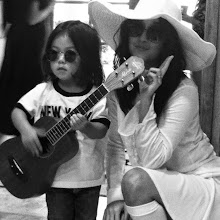 This project was about recognizing real superheroes in our community and in ourselves. I showed students work by Dulce Pinzon, a Mexican artist who photographed immigrants in their work environment dressed as superheroes. Her idea was to raise questions.. "of both our definition of heroism and our ignorance of and indifference to the workforce that fuels our ever-consuming economy." While showing students these slides we discussed what heroic traits each one possessed for their particular job and the broader question of what makes a person a superhero. Students thought of their own heroic traits and made a list of them, accompanying each one with a symbol. They sketched out their cape design, cut their symbols out of colored paper and glued them onto the cape. Lastly, students added more designs and details with oil pastel.
This project was about recognizing real superheroes in our community and in ourselves. I showed students work by Dulce Pinzon, a Mexican artist who photographed immigrants in their work environment dressed as superheroes. Her idea was to raise questions.. "of both our definition of heroism and our ignorance of and indifference to the workforce that fuels our ever-consuming economy." While showing students these slides we discussed what heroic traits each one possessed for their particular job and the broader question of what makes a person a superhero. Students thought of their own heroic traits and made a list of them, accompanying each one with a symbol. They sketched out their cape design, cut their symbols out of colored paper and glued them onto the cape. Lastly, students added more designs and details with oil pastel.Special thanks to the families of these students. When I asked them to think of real superheroes in their own lives, they thought of you. I also thank my friend Megan Ellis with whom I collaborated on this project during our student teaching at RISD. Your kindess and brilliance are inspiring:-)














